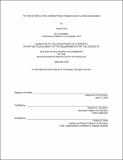| dc.contributor.advisor | Matthew D. Shoulders. | en_US |
| dc.contributor.author | Chen, Kenny,Ph. D.Massachusetts Institute of Technology. | en_US |
| dc.contributor.other | Massachusetts Institute of Technology. Department of Chemistry. | en_US |
| dc.date.accessioned | 2021-01-06T19:32:52Z | |
| dc.date.available | 2021-01-06T19:32:52Z | |
| dc.date.copyright | 2020 | en_US |
| dc.date.issued | 2020 | en_US |
| dc.identifier.uri | https://hdl.handle.net/1721.1/129211 | |
| dc.description | Thesis: Ph. D., Massachusetts Institute of Technology, Department of Chemistry, September, 2020 | en_US |
| dc.description | Cataloged from student-submitted PDF of thesis. Vita. | en_US |
| dc.description | Includes bibliographical references. | en_US |
| dc.description.abstract | The secretory pathway processes approximately one-third of the cellular proteome, modifying proteins with diverse chemical structures such as carbohydrates. These modifications can help guide protein folding and expand the functional diversity of the proteome, ultimately influencing intracellular signaling and extracellular interactions. The endoplasmic reticulum (ER) is the site of protein folding along the secretory pathway, featuring a suite of chaperones to assist protein folding and quality control factors for degrading misfolded proteins. Co- and post-translational modifications such as N-glycosylation take place in the ER, and glycoproteins are further processed in the Golgi to yield a vast array of N-glycan structures. During both normal physiology and disease, cells encounter environments that can result in proteotoxic stress. The proteostasis network safeguards against protein misfolding stress through the upregulation of chaperones and quality control factors. | en_US |
| dc.description.abstract | The unfolded protein response (UPR) regulates the ER's proteostasis network through the activity of transcription factors that remodel the expression of proteostasis regulators. Prior studies in our lab have established a role for the UPR's XBP1s transcription factor in N-glycan maturation, demonstrating that XBP1s bridges ER stress with the molecular architecture of N-glycans. However, these studies were limited to analyzing ectopically expressed model proteins. This thesis examines the role of XBP1s in regulating the structural distribution of N-glycans in endogenous systems, and explores the mechanisms by which XBP1s activation is regulated. We employed stress-independent activation of XBP1s and glycomic analyses by lectin microarrays and mass spectrometry to show that XBP1s drives significant changes in sialylation and bisecting GlcNAc in HEK293 cells, and in high-mannose, branched, and core fucosylated N-glycans in HeLa cells. | en_US |
| dc.description.abstract | We also inhibited formation of XBP1s in breast cancer cells displaying constitutively high levels of XBP1s to show that glycosylation features associated with malignancy are modestly affected when XBP1s formation is blocked. Lastly, we demonstrated that pharmacological activation of the IRE1-XBP1s signaling axis cannot be sustained despite loss of co-chaperones negatively regulating IRE1. Our results demonstrate that XBP1s is a significant regulator of both the UPR and N-glycosylation, and they emphasize the importance of studying the regulation of IRE1-XBP1s signaling for understanding disease targets. | en_US |
| dc.description.statementofresponsibility | by Kenny Chen. | en_US |
| dc.format.extent | 174 pages | en_US |
| dc.language.iso | eng | en_US |
| dc.publisher | Massachusetts Institute of Technology | en_US |
| dc.rights | MIT theses may be protected by copyright. Please reuse MIT thesis content according to the MIT Libraries Permissions Policy, which is available through the URL provided. | en_US |
| dc.rights.uri | http://dspace.mit.edu/handle/1721.1/7582 | en_US |
| dc.subject | Chemistry. | en_US |
| dc.title | The role of XBP1s in the unfolded protein response and N-linked glycosylation | en_US |
| dc.type | Thesis | en_US |
| dc.description.degree | Ph. D. | en_US |
| dc.contributor.department | Massachusetts Institute of Technology. Department of Chemistry | en_US |
| dc.identifier.oclc | 1227521716 | en_US |
| dc.description.collection | Ph.D. Massachusetts Institute of Technology, Department of Chemistry | en_US |
| dspace.imported | 2021-01-06T19:32:51Z | en_US |
| mit.thesis.degree | Doctoral | en_US |
| mit.thesis.department | Chem | en_US |
